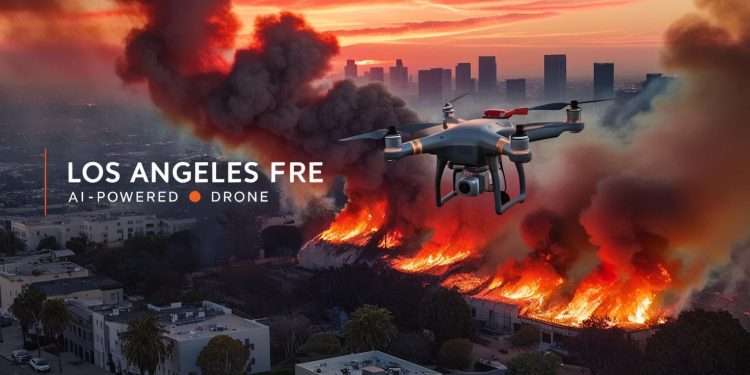
Los Angeles Wildfires faces its worst crisis yet as wildfires tear through the region and claim 24 lives. AI-generated disinformation has sparked widespread panic among residents. Deepfakes, including fake images of flames consuming the Hollywood sign, are spreading faster on social media platforms. Meta’s fact-checking teams work round the clock to curb misleading content – from false claims about looting to conspiracy theories that link the fires to political agendas.
This wave of misinformation takes advantage of people’s heightened emotions during crises. It creates dangerous gaps in reliable information that make recovery efforts more difficult. The situation reminds us of the Maui wildfires in 2023, when similar conspiracy theories spread through communities. Understanding how AI manipulation shapes public perception during natural disasters has become crucial. The combination of actual danger and artificial misinformation creates new challenges for emergency responders and public safety teams.
Table of Contents
Manipulation of Wildfire Data with Artificial Intelligence
AI-generated fake wildfire content is becoming a serious concern. A TikTok video showing Los Angeles in flames got over nine million views, yet it was completely fabricated. The video showed clear signs of artificial creation, with unnatural movements and elements that kept disappearing.
This problem goes beyond isolated cases. Another fake video showed the Hollywood Sign burning and racked up more than seven million views. The creator’s mistake became obvious when viewers spotted three “L”s in the sign instead of the correct two.
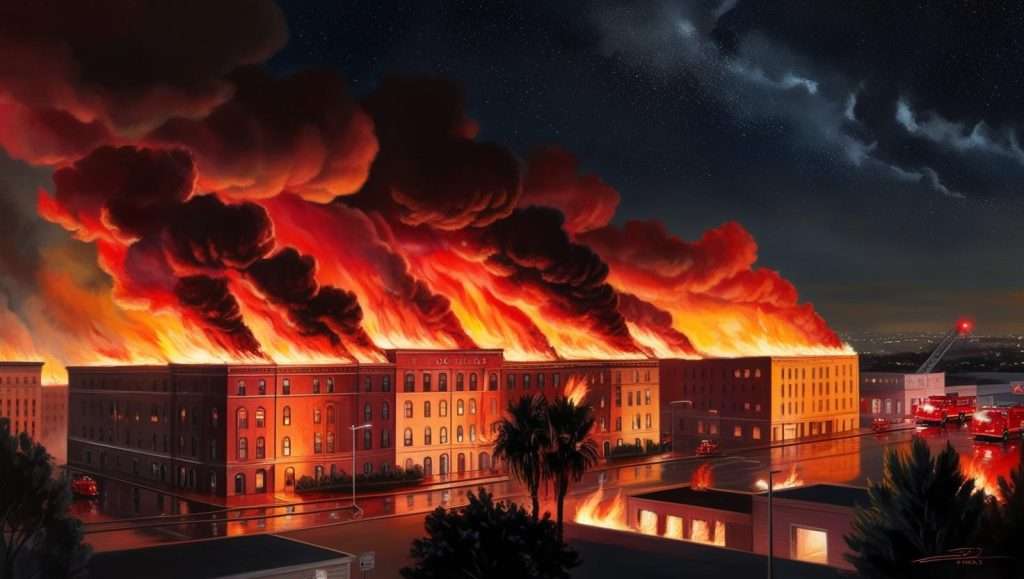
California’s firefighting teams have found legitimate ways to use AI with promising results:
- Early Detection Success:
- AI software spots fires 40% of the time before anyone calls 911
- The system caught about two dozen fires that no one reported
- The coverage now reaches 90% of California’s fire-prone regions
These technological advances come at a high environmental price. The AI systems need massive resources:
- A simple AI task uses about 500ml of water
- Training one AI model releases 626,000 pounds of carbon dioxide
- AI searches consume ten times more energy than regular searches
The California Department of Forestry and Fire Protection now uses AI-powered detection systems in all 21 command centers. We have a long way to go, but we can build on this progress. Human supervision remains vital since the system still generates many false alarms that need manual checking.
Drones and AI: Real-Time Los Angeles Wildfires Showcases
California’s firefighting capabilities have reached new heights with advanced drone technology and AI integration. CAL FIRE has doubled its drone deployment for critical operations , which helps them curb the Los Angeles Wildfires more effectively.
The ALERTCalifornia project leads this technological advancement with a network of over 1,140 AI-powered cameras that scan for early signs of fire outbreaks. Orange County has already proven this system’s worth by containing a fire to less than a quarter-acre.
The technology shows these key capabilities:
- Advanced Mapping Systems
- LiDAR technology creating detailed 3D maps
- Immediate terrain updates
- Strategic resource deployment planning
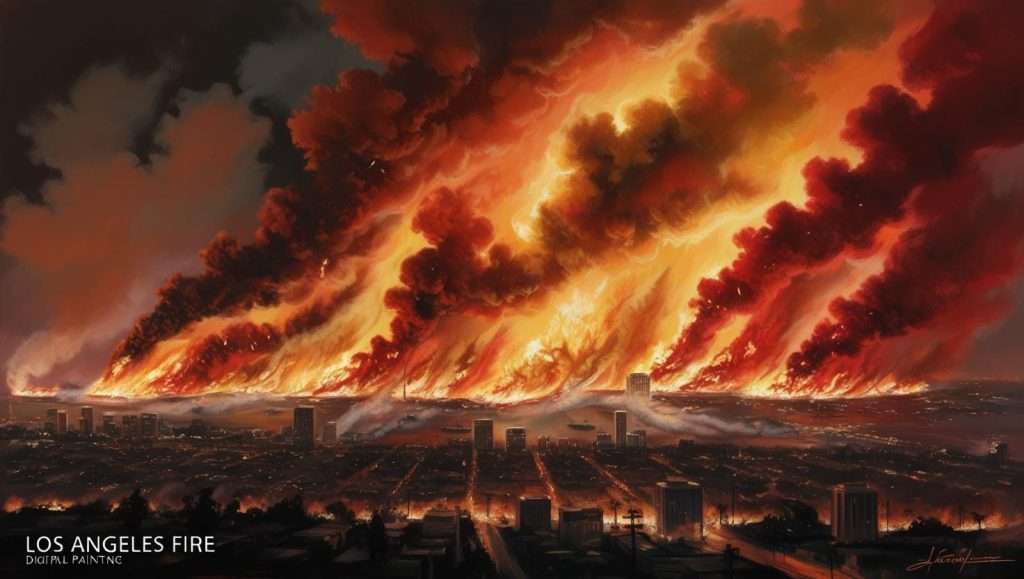
These drones perform multiple critical functions with their AI-boosted capabilities. They deliver fire suppression supplies to remote areas, create updated evacuation maps, and analyze environmental risk factors. Deep learning algorithms make precise fire detection and behavior prediction possible.
Without doubt, NASA’s development of an integrated AI-based formation method for drone fleets marks the most important advancement. This system processes on-board computing and ensures quick data transmission. The framework guides itself through challenging terrains and atmospheric conditions, which leads to more accurate and timely data.
Social Media Perception Manipulation: AI and Viral Sharing
AI-generated content about Los Angeles Wildfires now spreads like wildfire on social media platforms. McAfee’s research team found many deepfake images on major platforms. Some of these images got over a million views in just 24 hours.
Things got worse when AI-generated videos of a burning Hollywood sign went viral. These fake videos worked really well because people expect chaos during disasters. Even low-quality footage looks believable when there’s panic.
The team found several big problems with verification:
- AI detection tools showed 99.8% chance that viral videos were fake
- X, Facebook, and TikTok all got hit at the same time
- Anyone can make AI images because trial credits are easily available
Experts say our society’s values, not tech limits, are what makes misinformation spread. Research professor Jason Davis believes officials must speak up about false claims because “the stakes are too high”.
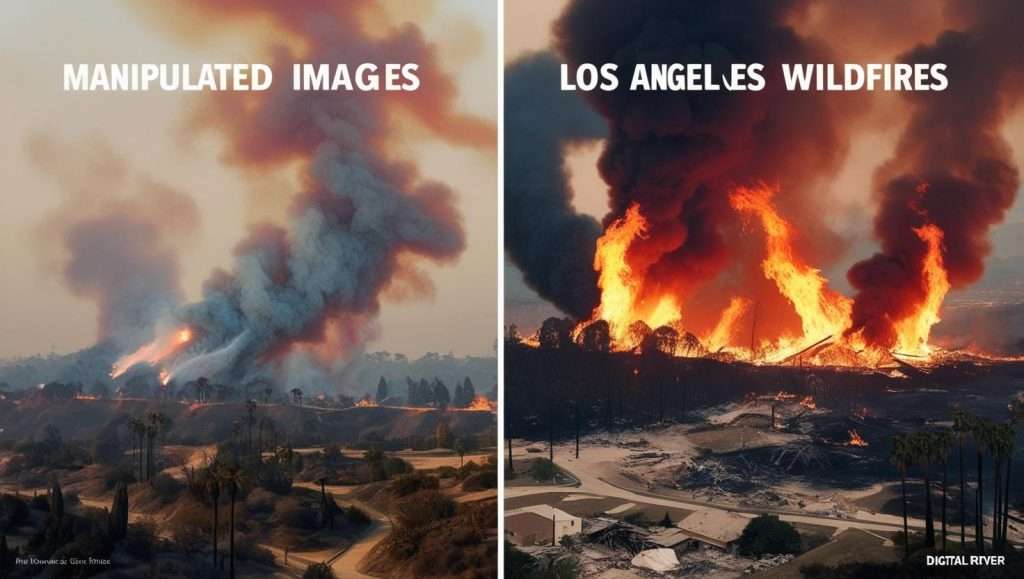
This crisis shows how social media users act like human sensors during disasters. They spot and document events as they happen. But this immediate coverage has turned into a problem – bad actors now use it to create panic with AI-generated content.
The Role of the Media: Creating ‘Los Angeles Wildfires Reality’ with AI
News outlets face unprecedented challenges as they cover Los Angeles Wildfires. Newsrooms must quickly share information while meticulously fact-checking AI-generated content.
Major news organizations struggle to keep their credibility as synthetic media floods the internet. Broadcast networks feel increasing pressure to verify footage authenticity before they air breaking news. Their verification process has:
- Advanced digital forensics analysis
- Cross-referencing with official sources
- Multi-layer authentication protocols
- Up-to-the-minute fact-checking systems
Media organizations need to balance speed with responsible journalism. Traditional news outlets often become the final barrier against misinformation, yet they face challenges with AI-powered content creation tools.
Decades-old media outlets now use strict verification protocols. Teams work tirelessly to authenticate wildfire footage and claims. This radical alteration from traditional reporting methods requires newsrooms to question whether AI tools generated any piece of content.
The digital world has become a complex ecosystem. AI technology helps and complicates reporting simultaneously. News organizations must protect their role as truth guardians while they adapt to these technological hurdles.
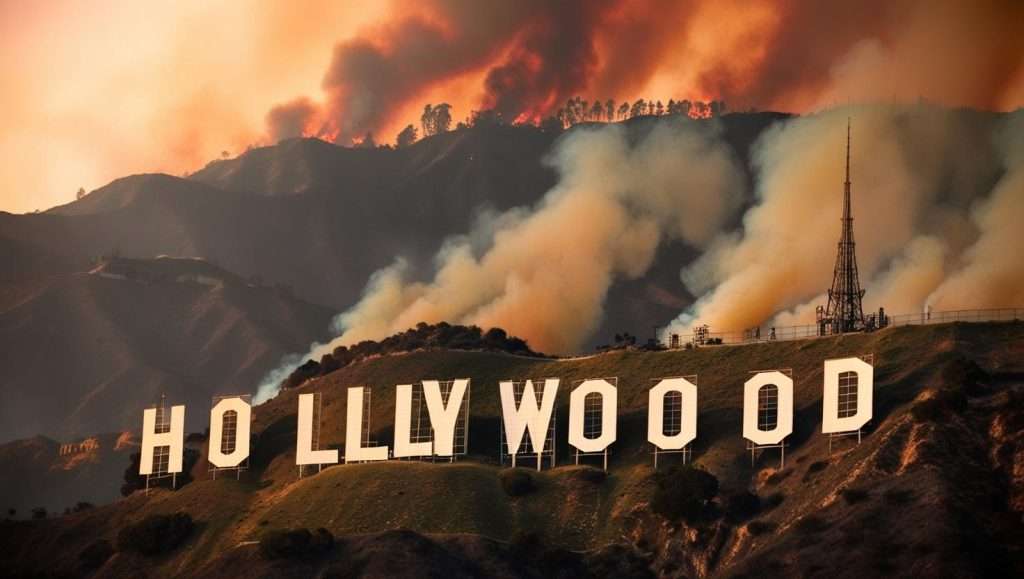
AI and Los Angeles Wildfires Spread Predictions: What Should Be the Real Situation?
Recent AI breakthroughs have created a clear divide between real wildfire prediction capabilities and twisted narratives. USC researchers built an innovative model that combines satellite images with AI algorithms to forecast wildfire paths, intensity, and growth rates accurately.
The model shows impressive results through these key metrics:
- It predicts wildfires with 80% accuracy 24 hours before they happen
- Tests on California wildfires between 2020-2022 proved successful
- The model analyzes weather, fuel, and terrain factors completely
This technological progress comes with environmental challenges. AI systems need significant resources:
- Each AI task uses about 500ml of water
- One AI model’s training releases 626,000 pounds of carbon dioxide
- AI searches use ten times more energy than regular searches
USC researchers use a conditional Wasserstein Generative Adversarial Network (cWGAN). This system excels at tracking wildfire progression through live satellite data. It stands as today’s most innovative approach to wildfire prediction because it considers complex factors like topography, weather conditions, and fuel availability.
These systems are a great way to get insights for emergency response teams. The technology has become a soaring win by analyzing more than 400 variables and delivers unprecedented accuracy in predicting fire behavior. This scientific breakthrough clearly contradicts the manipulated content that spreads across social media platforms.
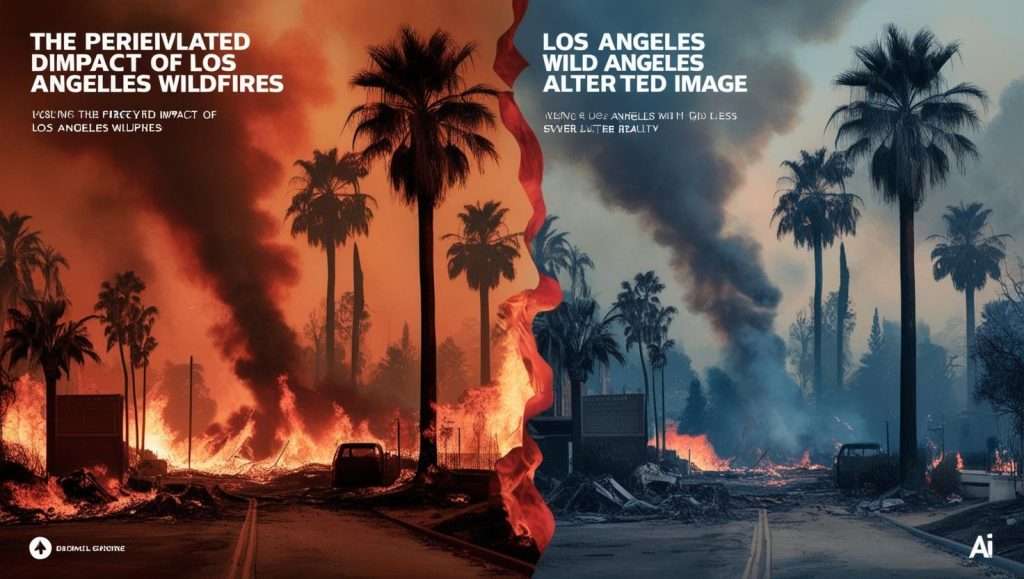
AI and Public Manipulation: A Strategy Based on Panic
The Los Angeles Wildfires crisis shows a troubling pattern of public manipulation through artificial intelligence. When an evacuation alert mistakenly went out to 10 million residents in Los Angeles County, it showed how technology errors can increase existing fears.
AI systems take a heavy toll on the environment. A single AI model creates 626,000 pounds of carbon dioxide emissions, which is five times what an average car produces in its lifetime. Each simple AI task uses more than 500ml of water.
The crisis affects public perception in several ways:
- Residents say they feel “on pins and needles” and constantly check multiple information sources
- Emergency services struggle to keep public trust
- AI risk modeling now guides insurance companies’ coverage decisions
Foreign actors have started to exploit this crisis. Chinese researchers developed advanced AI systems that create realistic social media personas to shape public opinion. These AI accounts blend naturally into online conversations and slip in targeted messages without drawing attention.
Microsoft’s research team found organized campaigns spreading false stories about the wildfires. These included claims about “weather weapons” backed by AI-created images. Such sophisticated disinformation shows how bad actors can use artificial intelligence to turn natural disasters into political tools.
While residents and emergency services battle the wildfires, AI-generated content reminds us that technology can either help or hurt crisis response efforts.
Conclusion: Reality Manipulated by AI
AI plays a complex role as both savior and saboteur during Los Angeles Wildfires. Real-life AI applications help firefighters detect blazes early. Malicious actors exploit this technology to spread panic through deepfakes and misinformation. The environmental impact raises serious concerns – each AI model’s training generates carbon emissions equivalent to five cars’ lifetime output.
Emergency response teams struggle with unprecedented challenges as they weigh technological benefits against synthetic media threats. Their success depends on spotting the difference between genuine alerts and AI-generated hoaxes. This crisis teaches valuable lessons about verifying information and deploying AI responsibly during disasters.
We need stronger defenses against AI-powered manipulation while embracing beneficial applications that save lives. This delicate balance shapes how we respond to future natural disasters effectively. The Los Angeles wildfire crisis reminds us that AI can either improve or undermine public safety – humans will decide which path to take.
FAQs
Q1. How are AI and drones being used to combat wildfires in Los Angeles?
Los Angeles Wildfires; AI-powered drones are being deployed for early fire detection, creating detailed 3D maps, delivering supplies to remote areas, and analyzing environmental risk factors. These technologies have significantly improved firefighting capabilities and response times.
Q2. What role does social media play in spreading misinformation about the Los Angeles wildfires?
Los Angeles Wildfires; Social media platforms have become hotspots for the rapid spread of AI-generated content about the wildfires. Deepfake images and videos, some garnering millions of views within hours, have complicated efforts to disseminate accurate information during the crisis.
Q3. How accurate are AI-powered wildfire prediction models?
Los Angeles Wildfires; Recent AI models developed by researchers have shown impressive accuracy, with some capable of predicting wildfires with 80% accuracy 24 hours before they occur. These models analyze hundreds of variables including weather, fuel, and terrain factors.
Q4. What challenges do news organizations face when reporting on the Los Angeles wildfires?
Los Angeles Wildfires; News outlets must balance rapid information dissemination with thorough fact-checking of potentially AI-generated content. They’ve implemented strict verification protocols and dedicated teams to authenticate footage and claims before broadcasting.
Q5. How is AI being misused to manipulate public perception during the wildfire crisis?
Los Angeles Wildfires; Malicious actors are using AI to create convincing deepfakes and false narratives about the wildfires. This includes generating fake social media personas to influence public opinion and spread conspiracy theories, complicating emergency response efforts and public trust.

